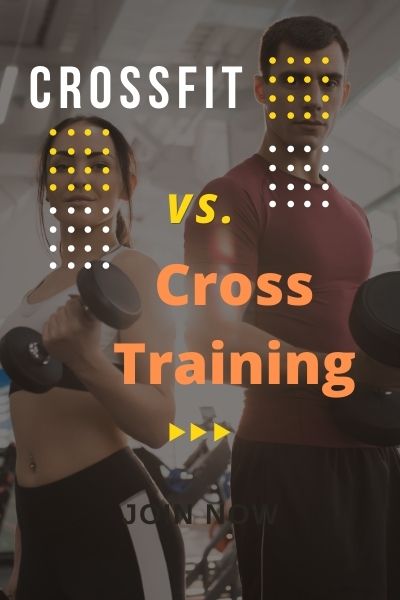Both Crossfit and cross-training advocate a multidimensional mindset towards fitness, yet there are differences between Crossfit and cross-training. Nonetheless, straight hypertrophy sets recommend following a defined strategy to achieve maximum muscular potential.
Crossfit focuses on functional movements that mimic activities you would do in everyday life. Nevertheless, cross-training aims to combine specific training modes to improve in the primary sport.
In this article, we will have an overview on Crossfit vs. cross-training. It provides a road map for those who need clarification in their decision-making.
Crossfit vs. Cross-training, What’s the Difference?
Cross-training is about combining your main sport with one or some other types of training to enhance functionality in your main sport or improve a weakness. A swimmer can combine TRX suspension training with their program; a climber may add running to their plan. In general, adding any of the major activities, such as running, swimming, or cycling to the main exercise will create a great combination.
Related read: Crossfit vs. TRX
Examples of Cross-training:
- Adding cycling to a runner’s training plan can enhance endurance
- Swimmers can practice with resistance bands to improve their pulling functionality
- Football players can add uphill running for better endurance
In all the above examples, there is a main exercise and the secondary exercise will help to improve certain aspects of it. Despite that, free fitness enthusiasts who practice to maintain and improve their overall well-being may incorporate different training modes for better functionality.
Crossfit, on the other hand, is a full-fledged training method. It is also a sports event, where people compete against each other. Crossfit, as a stand-alone exercise, provides a way to measure fitness level. However, they both follow a similar holistic approach towards fitness.
Moreover, athletes with a different primary sport sometimes choose Crossfit as a method for cross-training.
Also read: Bodyweight Crossfit.

What Are the Benefits of Cross-Training?
Cross-Training During Rest Days
Recovery is one of the components of any training program without which improvement is not possible. The human body restores and rebuilds itself during the recovery period, not during the exercise period. Continual exercise without proper rest will lead to overtraining.
Rest days do not have to be idle days. Active recovery is a type of recovery that allows restoration of physical features and, at the same time, maintains the athlete’s physical abilities at their peak. It can also reduce recovery time and prepare you for the next workout day.
So for example, if weight lifting is your main exercise, at your recovery time hit the pool for some swimming or water aerobics. This is an example of cross-training, where you incorporate another activity into your plan for active recovery. It also clarifies the distinction between Crossfit vs. cross-training, with Crossfit being one exercise routine.
Cross-training vs. Crossfit for Fitness
For individuals who do not use Crossfit as their primary workout, cross-training can bring about similar benefits. Engaging in different physical activities improves overall fitness. Be it in one package like Crossfit or a combination of separate activities.
Training muscles from different angles, blending cardio, weights, and stretches into the program enhance functionality and health benefits.
Nevertheless, Crossfit is specifically designed to improve fitness measures. Therefore, for the purpose of all-around fitness, Crossfit is the winner.
Cross-Training vs. Crossfit to Improve Sports Performance
The human body is an interconnected system in which every part contributes to the function of other parts. Your primary sport can challenge your physical abilities in a certain way, but overlook the importance of contributing organs and other factors. With cross-training, you can put special emphasis on those weaknesses that eventually will contribute to the performance of your primary sport.
This signifies another difference between Crossfit and cross-training. Crossfit does not prioritize a certain fitness measure, yet it aims to improve all aspects unbiasedly. However, cross-training can be crafted to specifically improve certain features that assist in the main sport. That means cross-training is a better option for athletes who follow certain primary sports.
Lose Weight by Cross-Training
According to the American Council on Exercise (ACE), cross-training increases the calorie burning rate, which speeds up weight loss. Engaging different muscle groups consumes more energy, and allows a more extended workout period.
Avoid Fitness Plateau with Cross-Training
Cross-training prevents your neuromuscular system from adapting to the exercise and hitting a plateau. Constantly alternating movements keeps the body guessing the next move. Hence, it has to always prepare for a new stimulus and keep the body fully alert.
Injury Prevention with Cross-Training
Cross-training can help with injury prevention in two major ways:
Overusing a specific muscle group will build up stress on the targeted muscles, tendons, and joints. Over time, due to lack of proper recovery, this added stress can cause injuries. Cross-training allows a shift from the organ under tension to another; or a change in the angle of pressure. This respite from routine provides enough opportunity for the muscles to recover, and thus reduces the risk of injury.
Moreover, in the human body, muscles work in pairs; they provide eccentric and concentric contractions. Reverse muscle imbalances can be a cause of injury. Tennis players are a perfect example of this type of injury when one side of the body becomes much stronger than the less dominant side. Also, when the playing muscle becomes stronger, but supporting muscles remain weak. Cross-training can compensate for this imbalance by training the opposite muscle groups.
In comparison between Crossfit vs. cross-training, Crossfit is notorious for its rate of injuries.
Also read, Crossfit Neck Pain: Treatment and Cause.
Disadvantages of Cross-Training Exercise
- It is a lot of challenge for newbies. It is better to reach a certain level of fitness with primary exercise before opting to add another.
- Combining different exercise regimens can be time-consuming and probably does not suit everyone’s schedule.
- Cross-training requires some degree of mastery in two or more different types of exercise. However, exercises like running and cycling do not require that much knowledge and are more accessible.
In comparison between Crossfit vs. cross-training, for those who do not have enough knowledge or time to combine different modes of training, Crossfit is a more possible option. You can register with one coach and progress in a wide range of fitness measures.
Is Crossfit Good for Cross-Training?
It depends on many other factors, such as the purpose of the training, fitness level of the trainee, and demands of the primary sport. Sometimes yes, Crossfit is good for cross-training; footballers, weight lifters, and gymnasts can use Crossfit to become well-developed in different aspects.
As it was mentioned, another difference between Crossfit and cross-training is that cross-training can be designed specifically to improve a particular ability based on the primary sport. In that respect, for professional athletes, cross-training is the way to go.
Why is Cross-training Important?
- Balance, Every training regimen has strengths and weaknesses. With cross-training, we can work on the imbalances and improve weaknesses.
- Diversification of exercises. While it is important to choose a primary form of exercise, conditions change. Sometimes due to lifestyle, we have to do calisthenics instead of weight. So, it’s better to be prepared for it.
- It reduces the risk of injury.
- It is a Crossfit type of training; particularly if you do not have access to Crossfit gyms.
Am I Too Old for Crossfit?
Another difference between Crossfit and cross-training is that Crossfit is a compact package of intense activities. For older people, it can be too extreme to overload their body with that level of intensity.
On the other hand, cross-training is more flexible and allows you to select different modes, intensities, and variations based on needs, age, and fitness level. For example, a combination of swimming and climbing can be a perfect training regimen with unique mental and physical benefits.
Also read: How to Do Knees to Elbows Crossfit?





